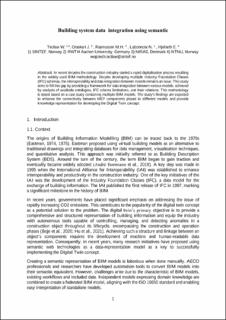Building system data integration using semantic
| dc.contributor.author | Teclaw, Wojciech | |
| dc.contributor.author | Oraskari, J. | |
| dc.contributor.author | Rasmussen, M.H. | |
| dc.contributor.author | Labonnote, Nathalie | |
| dc.contributor.author | Hjelseth, Eilif | |
| dc.date.accessioned | 2024-02-29T07:22:56Z | |
| dc.date.available | 2024-02-29T07:22:56Z | |
| dc.date.created | 2024-02-25T09:50:37Z | |
| dc.date.issued | 2023 | |
| dc.identifier.isbn | 0-000-00001-9 | |
| dc.identifier.uri | https://hdl.handle.net/11250/3120374 | |
| dc.description.abstract | In recent decades the construction industry started a rapid digitalisation process resulting in the widely used BIM methodology. Despite developing multiple Industry Foundation Classes (IFC) schemas, the interoperability and data integration between models remains an issue. This study aims to fill this gap by providing a framework for data integration between various models, achieved by analysis of available ontologies, IFC schema limitations, and their relations. This methodology is tested based on a case study containing multiple BIM models. The study's findings are expected to enhance the connectivity between MEP components placed in different models and provide knowledge representation for developing the Digital Twin concept. | en_US |
| dc.language.iso | eng | en_US |
| dc.publisher | EG-ICE | en_US |
| dc.relation.ispartof | The 30th EG-ICE: International Conference on Intelligent Computing in Engineering | |
| dc.title | Building system data integration using semantic | en_US |
| dc.type | Chapter | en_US |
| dc.description.version | publishedVersion | en_US |
| dc.identifier.cristin | 2249483 | |
| cristin.ispublished | true | |
| cristin.fulltext | original |
Tilhørende fil(er)
Denne innførselen finnes i følgende samling(er)
-
Publikasjoner fra CRIStin - SINTEF AS [5802]
-
SINTEF Community [2248]
